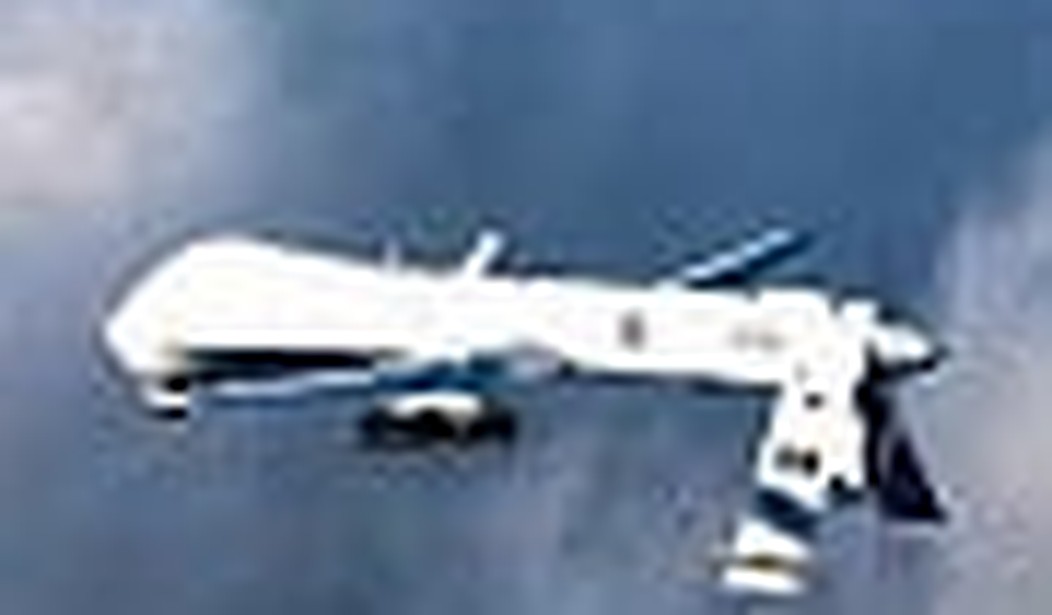I called the Pentagon recently to talk with the press office about how the drone campaign is going in Pakistan. Drones, or pilotless aircraft, have been taking out al-Qaeda operatives in the tribal areas of Pakistan with great aplomb since last summer. Consequently, the attacks continue to remain page A-1 headline news.
When I asked about the campaign’s progress, Department of Defense Spokesman Lt. Col. Mark Wright laughed out loud for 20 seconds. That seems like a long time for a Pentagon official to have a chuckle with a reporter these days, and it was refreshing in its own way. Nonetheless, I asked, “Why are you laughing?” I thought I knew why, but I wanted to see what Wright had to say.
“I can’t give you any information on that,” Wright said. He was careful to say “that” and not “drone.” While the drone strikes are front page news in every major paper in America these days, officially they are not happening. They don’t exist.
“And why is that?” I asked.
Wright laughed again. “I can’t give you any information on why I can’t give you any information,” he said. It seemed like he knew how funny this sounded. How clichéd. We then discussed the history of drones for a few minutes, reflecting on their use beginning in the early days of the Cold War. Drones were first used on intelligence gathering missions back when Eisenhower was president. “We’ve had drones and we’ve used them for years,” Wright said, carefully choosing the grammatical tense. Drones never use to be armed with missiles — weapons weren’t married to drones until the year 2000.
The original government partnership on the use of drones began then as it continues today: as a joint CIA/Air Force endeavor. The ties that bind these two services in the use of drones — services that generally spend more time at odds with one another than working together — is the concept of plausible deniability. This serves both organizations. The CIA doesn’t have to say what it does in the skies over Pakistan, certainly not in the same way the U.S. Air Force has to.
“We’re loathe to comment about any involvement in this at the request of the agency,” Wright said, adding, “and as a rule, the CIA doesn’t comment on classified missions and these are all classified.”
I told Wright that I had a specific question about a specific war on terror player, a man on the FBI’s Most Wanted list. It was newsworthy and should not be classified, I argued. According to a January 8 story by ABC’s investigative team, al-Qaeda operative Fahid Msalam had been taken out by a CIA drone strike on New Year’s Day. I wanted to know if it was true.
Msalam was indicted in the 1998 bombings of the U.S. embassies in Tanzania and Kenya, in which hundreds of people, including Americans, were killed. As a result, the FBI has offered $5 million reward for information on Msalam.. A fugitive for 10 years, Msalam recently resurfaced in Pakistan. It is alleged that Msalam played a role in the September 2008 attack on the Marriott Hotel in Islamabad and was also involved in an attempt to assassinate former Pakistani Prime Minister Benazir Bhutto. Bhutto was killed in a later attack. A native of Kenya, Msalam is regarded as a key player who helped train recruits from East Africa and Afghanistan for jihad.
Shortly after the ABC story claimed Msalam and his long time al-Qaeda colleague Sheikh Ahmed Salim Swedan were killed, I called the FBI to confirm this. The FBI did not. Instead, in a written statement, FBI Public Affairs’ Susan T. McKee said, “The FBI is not commenting on Fahid Mslalam’s [sic] status at this time.”
Last week, the Wall Street Journal printed a list of top-priority targets killed since the summer by drones. While Sheikh Swedan was listed as dead, Msalam was mysteriously absent from the list. I requested from Wright the Pentagon’s list of al-Qaeda operatives killed in Pakistan since the summer of 2008, the same list the Wall Street Journal must have used.
“We don’t have a list,” said Wright.
“Where do reporters get their information about who’s been killed?” I asked.
“The Pentagon is a big place. There are leaks,” said Wright. No laughter this time.
“Wouldn’t it be better to produce an accurate list? I asked. Wright replied, “To be able to talk about that would be to hit the subject directly, which I am not authorized to do.”
Hitting the subject directly. Now, isn’t that the real truth about drones? Why then, should who has been hit remain a mystery?









Join the conversation as a VIP Member